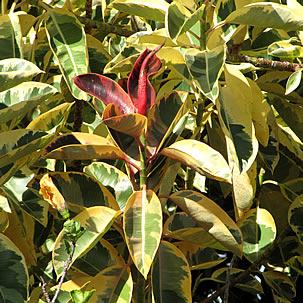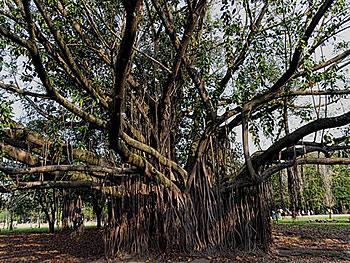The Rubber Plant (Ficus elastica) is an evergreen, decorative tree native to Tropical Asia and used ornamentally in various regions worldwide, especially in interior decoration. It has a sturdy trunk, reaching up to 6.56 feet (2 meters) in diameter, and is highly branched, often producing a short trunk from the base. Individuals cultivated in open spaces develop aerial roots that, upon reaching the ground, root and thicken, producing auxiliary trunks that allow the expansion of the canopy. In its natural habitat, the Rubber Plant can reach a height of 60 meters (196.85 feet), but when cultivated outside its habitat, it rarely exceeds 66 feet (20 meters). The trunk bark is smooth, shiny, ranging from brown to gray, with grooves.

The leaves of the Rubber Plant are large, alternate, petiolate, entire, oval to elliptical, leathery, shiny, with a prominent central vein and well-defined margins. Initially erect, they become horizontal and then pendulous over time. They are reddish when young and take on shades of olive green in the typical species, but there are also cream and yellow variegated varieties, as well as options with reddish-colored leaves. However, the most common cultivar is the “Robusta,” with green and rigid leaves. Other popular cultivars include “Burgundy,” with broad, deep green leaves and a wine-colored background, and “Ruby,” variegated with cream, pink, red, and green spots, resembling a true watercolor.
Ficus elastica has inflorescences in syconia (figs), spherical and about 0.39 inches (1 centimeter) in diameter. Like other species in the fig family, the Rubber Plant evolved to depend on a specific wasp for pollination, a process that only occurs in its place of origin. Therefore, it is unlikely to propagate by seeds in other locations.
Most commonly used in pots, this lush and tropical fig tree is perfect for breaking the monotony in various indoor settings. It thrives in direct sunlight, so be sure to cultivate it near a window or skylight. Maintenance is low, involving regular watering and fertilization. Renewal, training, or containment pruning may be necessary, but these are simple and easy to perform, requiring care to protect hands with gloves due to the plant’s irritating sap. Repotting should be done every two years, trimming excess roots and preferably replanting in a larger pot.
It is crucial to observe its growth in indoor environments. Plants with sparse canopies, sudden leaf drop, or stagnant growth indicate low light conditions. It is not uncommon for neglected plants, often without replanting, to have tangled roots, growing beyond the drainage hole.

In gardens, the Rubber Plant forms a giant living sculpture, with aerial roots everywhere and a lush umbrella-shaped canopy. It casts a cool shade and tends to spread continuously, both in the sky and on the ground. For this reason, and due to its roots that often lift and thicken, as well as spread superficially, the Rubber Plant is considered a tree with aggressive roots. Its planting is suitable for large spaces such as parks, farms, parking lots, and extensive gardens. Its use in urban tree planting should be avoided, as it tends to compromise structures, buildings, and buried pipelines, in addition to its large size.
This species’s latex is also used to produce rubber, although it has lower yield and quality compared to the true rubber tree (Hevea brasiliensis), native to Brazil.
Ficus elastica should be cultivated in full sun, partial shade, or diffuse light, in fertile soil enriched with organic matter and regularly irrigated. The Rubber Plant appreciates tropical heat and humidity, typical of its habitat. Therefore, it likes frequent watering without waterlogging. Similarly, it fears intense cold or frost, although it can tolerate light frosts. It can be grown in heated environments, but in this case, regularly spray water on its leaves to prevent excessive drying. Propagation is done by stem and bud cuttings, as well as air layering, and it roots better with the use of hormones.


